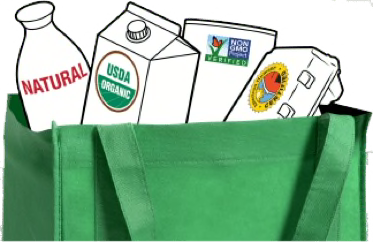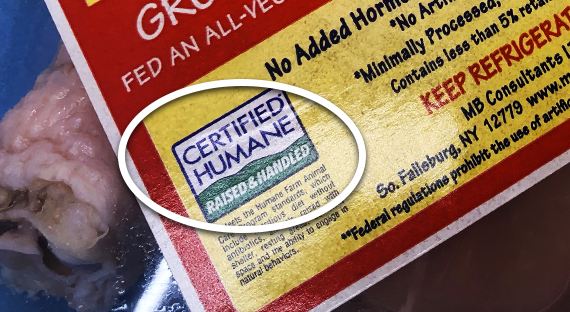The Certified Humane label on beef does not guarantee that beef cattle were able to graze in a pasture their entire lives. Cattle may be housed in feedlots; however, the feedlot conditions are better than the industry standard. The animals must be given shade and shelter. Feedlots can't be excessively muddy, and the animals must have a dry place to lie down. The standards allow physical alterations, such as surgical castration without pain relief on calves less than seven days old, and hot iron branding. However, pain relief is required if the animals' horns are to be removed. Farms and slaughterhouses may not use electric prods to get the animals to move (except as a last resort).
Animals can't be confined in tie stalls (where cows are chained around the neck to a stall that is big enough for them to stand and lie down but not to turn around) and must be able to move freely. They must have access to an outdoor exercise area, but putting them on a pasture to graze isn't required. All animals have clean bedding. Tail docking isn't permitted.
Outdoor access isn't required, but the birds are given slightly more room than what's the industry norm. They're also provided with environmental enrichment, such as straw bales and scattered grains, to relieve boredom and keep them active. Litter in the chicken house must be kept clean, dry, and dust-free, and must be changed between flocks. The standards prohibit the common practice of keeping the lights on nearly continuously in the chicken house. (That practice—which prevents the birds from sleeping, so they eat more, promoting faster growth—is a major animal welfare issue in chicken production.) Indoor ammonia levels (produced by animal waste), which when high can cause illness, must be controlled. There are no legal humane slaughter standards for chickens, as there are for other animals, but the Certified Humane standards mandate them. Birds must be adequately stunned before slaughter and checked to make sure they are not still alive when they enter a tank of scalding water (which makes feather removal easier). A company-appointed "animal welfare officer" must be at the slaughterhouse to check for this and to perform other animal-welfare-related duties.
Cages are prohibited, but the minimum space per hen can be as little as 1 square foot per bird. The standards require perches and nest boxes, both of which are important for laying hens, but no outdoor access or ways of engaging in natural scratch-and-peck behavior. (If you see a Certified Humane seal plus a "pasture raised" or "free range" claim on a carton of eggs, however, it means that the hens were required to have outdoor access.) When hens are housed in crowded conditions and can't scratch and peck, they may become aggressive and peck each other. Beak trimming is allowed to minimize the harm this can inflict. Indoor ammonia levels (produced by animal waste), which when high can cause illness, must be controlled.
The standards prohibit the confinement of breeder pigs (the female pigs that spend their lives in a cycle of pregnancy and nursing piglets) in narrow, barren crates, which is a major welfare concern in pork production. Breeder pigs must be housed in pens large enough to allow turning around, with materials such as straw to engage in their natural nesting behaviors, prior to giving birth. When the piglets are weaned, the "growing pigs" (those that will be slaughtered for meat when they reach market weight) are moved to group housing that provides a bedded space for each pig, though the minimum space requirements in the standards are small and do not allow much freedom of movement. (A 250-pound growing pig has a space of 10 square feet.) While outdoor access is not required, the farms do have to provide the pigs with materials, such as straw or wood chips, to engage in their natural rooting behaviors indoors. This can prevent the problem of bored pigs biting each other's tails and eliminates the need for tail docking. Certified Humane standards prohibit tail docking except in "exceptional circumstances," and then the cause of the problem needs to be addressed. Animal handlers on farms and in slaughterhouses may not use electric prods to get the animals to move (except as a last resort).
Most farms and all slaughterhouses are inspected annually. A strength of the verification process is that Humane Farm Animal Care inspectors have advanced degrees in animal science.

Consumer Reports takes a detailed look at the requirements, definitions, standards, and verification procedures behind food labeling seals and claims, and distills this information into CR ratings. Our goal is to inform and empower consumers so they can act to create demand for a healthier, safer food system.


























